Click image for BBB rating
See our Privacy Policy
cool="cool" width="786" height="10488" border="0" cellpadding="0" cellspacing="0" gridx="16" showgridx="showgridx" usegridx="usegridx" gridy="16" showgridy="showgridy" usegridy="usegridy" bgcolor="#99ccff">
|
|
|
 |
|
|
|
|
|
|
Welcome to Spaightwood Galleries, Inc.
120 Main Street, Upton MA 01568-6193
|
|
|
|
|
Etienne Delaune was a goldsmith, medalist, draftsman, and engraver. He was appointed tot he Royal mint in January 1552 but removed about six months later. He did not become an engraver until c. 1557 His first dated prints, however, were made in 1561; they included a series of 12 prints illustrating scenes from the Old Testament as well as 2 designs for medals. According to Marianne Grivel's entry on him in The Grove Dictionary of Art, "he found his models in the works of such artists in the Fontainebleau school as Rosso Fiorentino, Nocolò dell'Abate and especially Luca Penni, rather than Primaticcio"; however, he also hearkened back to the Raphael School on occasion (see the engraving after Marcantonio Raimonid below). Delaunne was a Calvinist and had to flee Paris during the St. Bartholomew's Eve Massacre (August 24, 1572), finding refuge in Strasbourg. He was back in Strausbourg in 1580 (after working in Augsburg for a while in 1576), where he published a set of 20 moral allegories based upon drawings by his som Jean. His last dated engraving dates from 1582. According to Marlene Grivel, "delaunne was a skilled practionioner of the Italianate style favoured at the Valios court. HIs engravings of mythological and allegorical subjects, and especially his ornamental designs for jewelry and goldsmiths' work, of great precision despite their small dimensions, contributed to the spread of the Fontainebleau style among a wide variety of artists and craftsman in France and abroad" (8:660). The standard catalogue raisonné is still Robert-Dumesnil's 1865 Le Peintre-Graveur Français, IX:16-130, which describes 443 works. An illustrated catalgue raisonné (like The Illustrated Bartsch) would be a lovely addition to the libraries of those interested in his work. 17 of Delaune's engravings are illustrated and discussed in massive catalog for The French Renaissance in Prints from the Biblitèque National de France which was shown at UCLA in the Armand Hammer Museum of Art and Cultural Center, the Metropolitan Museum of Art in NY City, and the Biblitèque National de France during 1994 and 1995 (see pages 350-364). Delaunne's work is also discussed breifly in The School of Fontainebleau: An Exhibition of Paintings, Drawings, Engravings, and Sculpture 1530-1619 (Fort Worth Art Center and University Art Museum, University of Texas (1965), p. 50. Fontainbleau et l'estampe en France au XVIe Siecle: Iconographie et Contradictions (Le Chatou-MuséeVille de Nemours, 1985), contains illustrations of 49 engravings by Etienne (or Etienne and his son Jean) Delaune. Since the work is organized by topic, not by artist, it takes some sleuthing to discover them all).
|
|
|
|
|
|
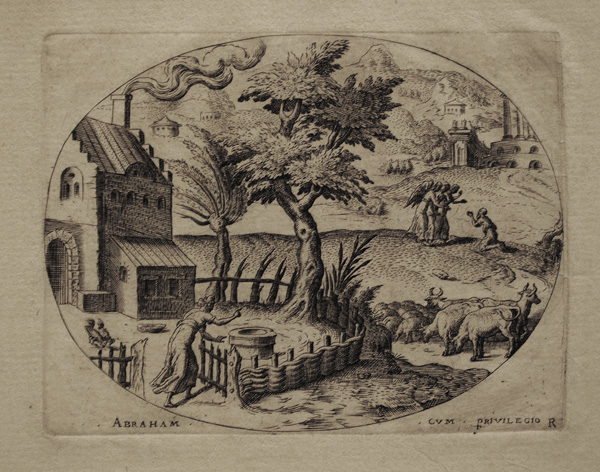 |
|
|
|
Abraham receiving the angels (R-D 6). This is part of a series of 12 engravings ini ovals. Inscribed "ABRAHAM" in the plate lower left and "Cvm Privilego R" lower right. A rich impression with margins. This print has been trimmed just on or within its borders. The scene is based upon Genesis 18: 1-15: "The Lord appeared to Abraham by the oaks of Mamre, as he sat at the entrance of his tent in the heat of the day. He looked up and saw three men standing near him. When he saw them, he ran from the tent entrance to meet them, and bowed down to the ground. He said, ‘My lord, if I find favour with you, do not pass by your servant. Let a little water be brought, and wash your feet, and rest yourselves under the tree. Let me bring a little bread, that you may refresh yourselves, and after that you may pass on—since you have come to your servant.’ So they said, ‘Do as you have said.’ And Abraham hastened into the tent to Sarah, and said, ‘Make ready quickly three measures of choice flour, knead it, and make cakes.’ Abraham ran to the herd, and took a calf, tender and good, and gave it to the servant, who hastened to prepare it. Then he took curds and milk and the calf that he had prepared, and set it before them; and he stood by them under the tree while they ate. They said to him, ‘Where is your wife Sarah?’ And he said, ‘There, in the tent.’ Then one said, ‘I will surely return to you in due season, and your wife Sarah shall have a son.’ And Sarah was listening at the tent entrance behind him. Now Abraham and Sarah were old, advanced in age; it had ceased to be with Sarah after the manner of women. So Sarah laughed to herself, saying, ‘After I have grown old, and my husband is old, shall I have pleasure?’ The Lord said to Abraham, ‘Why did Sarah laugh, and say, “Shall I indeed bear a child, now that I am old?” Is anything too wonderful for the Lord? At the set time I will return to you, in due season, and Sarah shall have a son.’ But Sarah denied, saying, ‘I did not laugh’; for she was afraid. He said, ‘Oh yes, you did laugh.’ " Image size: 67x89mm. Price: Please call or email for current pricing information.
|
|
|
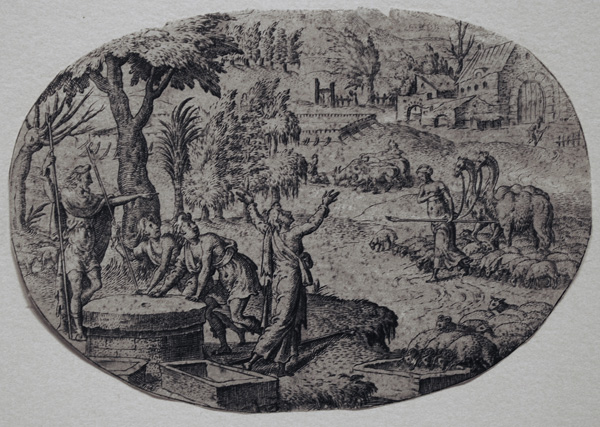 |
|
|
The Meeting of Jacob and Rachel (R-D 9). This is part of a series of 12 engravings ini ovals. A rich impression with two small nicks top left and right. This print has been trimmed just on or within its borders. The scene is based upon Genesis 29: 4-12: "Jacob said to them, ‘My brothers, where do you come from?’ They said, ‘We are from Haran.’ He said to them, ‘Do you know Laban son of Nahor?’ They said, ‘We do.’ He said to them, ‘Is it well with him?’ ‘Yes,’ they replied, ‘and here is his daughter Rachel, coming with the sheep.’ He said, ‘Look, it is still broad daylight; it is not time for the animals to be gathered together. Water the sheep, and go, pasture them.’ But they said, ‘We cannot until all the flocks are gathered together, and the stone is rolled from the mouth of the well; then we water the sheep.’ While he was still speaking with them, Rachel came with her father’s sheep; for she kept them. Now when Jacob saw Rachel, the daughter of his mother’s brother Laban, and the sheep of his mother’s brother Laban, Jacob went up and rolled the stone from the well’s mouth, and watered the flock of his mother’s brother Laban. Then Jacob kissed Rachel, and wept aloud. And Jacob told Rachel that he was her father’s kinsman, and that he was Rebekah’s son; and she ran and told her father." Image size: 61x86mm. Price: Please call or email for current pricing information.
|
|
|
|
|
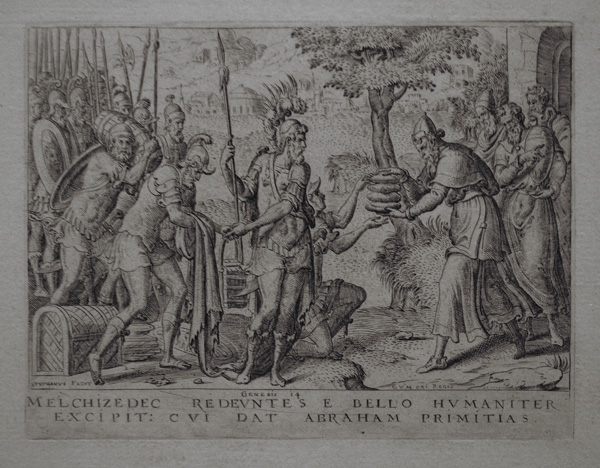 |
|
|
|
Melchisadec greeting Abraham with bread and wine (R-D 39). Original engraving, c. 1557. Signed in the plate lower left: "Stephanus fecit" and inscribed lower right "Cum. Priv. Regis." Genesis 14 is cited in the text below the engraving as the source of the scene: "After his return from the defeat of Chedorlaomer and the kings who were with him, the king of Sodom went out to meet him at the Valley of Shaveh (that is, the King’s Valley). And King Melchizedek of Salem brought out bread and wine; he was priest of God Most High. He blessed him and said,
‘Blessed be Abram by God Most High,
maker of heaven and earth;
and blessed be God Most High,
who has delivered your enemies into your hand!’
And Abram gave him one-tenth of everything." (Genesis 14: 17-20). A very good impression with ample margins. Image size: 78x103mm. Price: Please call or email for current pricing information.
|
|
|
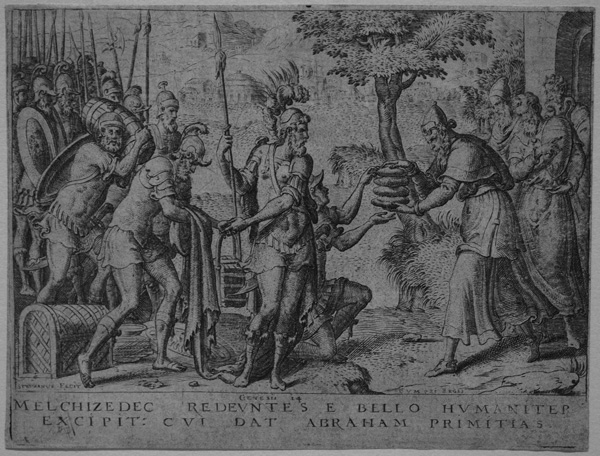 |
|
|
Melchisadec greeting Abraham with bread and wine (R-D 39). Original engraving, c. 1557. Signed in the plate lower left: "Stephanus fecit" and inscribed lower right "Cum. Priv. Regis." Genesis 14 is cited in the text below the engraving as the source of the scene: "After his return from the defeat of Chedorlaomer and the kings who were with him, the king of Sodom went out to meet him at the Valley of Shaveh (that is, the King’s Valley). And King Melchizedek of Salem brought out bread and wine; he was priest of God Most High. He blessed him and said,
‘Blessed be Abram by God Most High,
maker of heaven and earth;
and blessed be God Most High,
who has delivered your enemies into your hand!’
And Abram gave him one-tenth of everything." (Genesis 14: 17-20). A very good impression trimmed on or within the platemark. Image size: 78x104mm. Price: Please call or email for current pricing information.
|
|
|
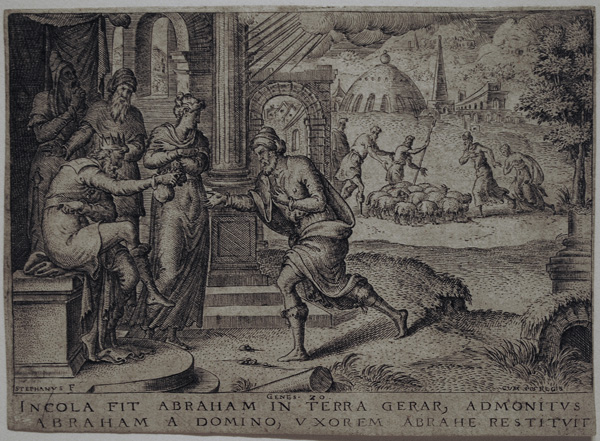 |
|
|
Abimelech restores Sarah to Abraham (R-D 44). Original engraving, c. 1555. Signed in the plate lower left: "Stephanus fecit" and inscribed lower right Cum. Priv. Regis." Genesis 20 is cited in the text below the engraving as the source of the scene: "From there Abraham journeyed towards the region of the Negeb, and settled between Kadesh and Shur. While residing in Gerar as an alien, Abraham said of his wife Sarah, ‘She is my sister.’ And King Abimelech of Gerar sent and took Sarah. But God came to Abimelech in a dream by night, and said to him, ‘You are about to die because of the woman whom you have taken; for she is a married woman.’ Now Abimelech had not approached her; so he said, ‘Lord, will you destroy an innocent people? Did he not himself say to me, “She is my sister”? And she herself said, “He is my brother.” I did this in the integrity of my heart and the innocence of my hands.’ Then God said to him in the dream, ‘Yes, I know that you did this in the integrity of your heart; furthermore it was I who kept you from sinning against me. Therefore I did not let you touch her. Now then, return the man’s wife; for he is a prophet, and he will pray for you and you shall live. But if you do not restore her, know that you shall surely die, you and all that are yours.’ So Abimelech rose early in the morning, and called all his servants and told them all these things; and the men were very much afraid. Then Abimelech called Abraham, and said to him, ‘What have you done to us? How have I sinned against you, that you have brought such great guilt on me and my kingdom? You have done things to me that ought not to be done.’ And Abimelech said to Abraham, ‘What were you thinking of, that you did this thing?’ Abraham said, ‘I did it because I thought, There is no fear of God at all in this place, and they will kill me because of my wife. Besides, she is indeed my sister, the daughter of my father but not the daughter of my mother; and she became my wife. And when God caused me to wander from my father’s house, I said to her, “This is the kindness you must do me: at every place to which we come, say of me, He is my brother.” ’ Then Abimelech took sheep and oxen, and male and female slaves, and gave them to Abraham, and restored his wife Sarah to him. Abimelech said, ‘My land is before you; settle where it pleases you.’ " (Genesis 20: 1-15). A very good early impression trimmed on or within the platemark. Image size: 75x104mm. Price: Please call or email for current pricing information.
|
|
|
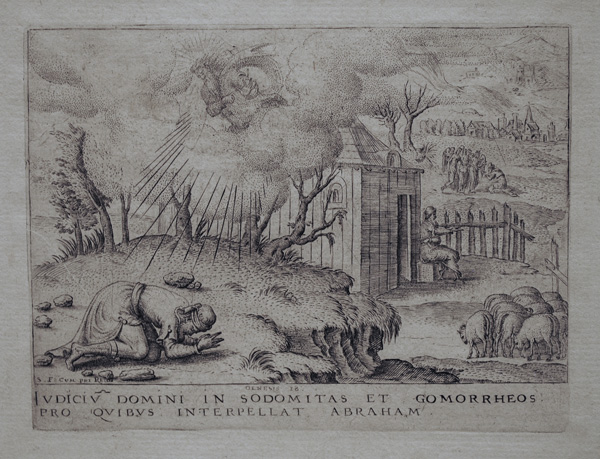 |
|
|
Abraham intercedes with God for the preservation of Sodom and Gomorrah (R-D 41). Original engraving. Signed in the plate lower left: "S[tephanvs] F[ecit] Cvm Pri[vileg] Regis." Genesis 18 is cited in the text below the engraving as the source of the scene: "The Lord said, ‘Shall I hide from Abraham what I am about to do, seeing that Abraham shall become a great and mighty nation, and all the nations of the earth shall be blessed in him? No, for I have chosen him, that he may charge his children and his household after him to keep the way of the Lord by doing righteousness and justice; so that the Lord may bring about for Abraham what he has promised him.’ Then the Lord said, ‘How great is the outcry against Sodom and Gomorrah and how very grave their sin! I must go down and see whether they have done altogether according to the outcry that has come to me; and if not, I will know.’ So the men turned from there, and went towards Sodom, while Abraham remained standing before the Lord. Then Abraham came near and said, ‘Will you indeed sweep away the righteous with the wicked? Suppose there are fifty righteous within the city; will you then sweep away the place and not forgive it for the fifty righteous who are in it? Far be it from you to do such a thing, to slay the righteous with the wicked, so that the righteous fare as the wicked! Far be that from you! Shall not the Judge of all the earth do what is just?’ And the Lord said, ‘If I find at Sodom fifty righteous in the city, I will forgive the whole place for their sake.’ Abraham answered, ‘Let me take it upon myself to speak to the Lord, I who am but dust and ashes. Suppose five of the fifty righteous are lacking? Will you destroy the whole city for lack of five?’ And he said, ‘I will not destroy it if I find forty-five there.’ Again he spoke to him, ‘Suppose forty are found there.’ He answered, ‘For the sake of forty I will not do it.’ Then he said, ‘Oh do not let the Lord be angry if I speak. Suppose thirty are found there.’ He answered, ‘I will not do it, if I find thirty there.’ He said, ‘Let me take it upon myself to speak to the Lord. Suppose twenty are found there.’ He answered, ‘For the sake of twenty I will not destroy it.’ Then he said, ‘Oh do not let the Lord be angry if I speak just once more. Suppose ten are found there.’ He answered, ‘For the sake of ten I will not destroy it.’ And the Lord went his way, when he had finished speaking to Abraham; and Abraham returned to his place. (Genesis 18: 17-33)."
|
|
|
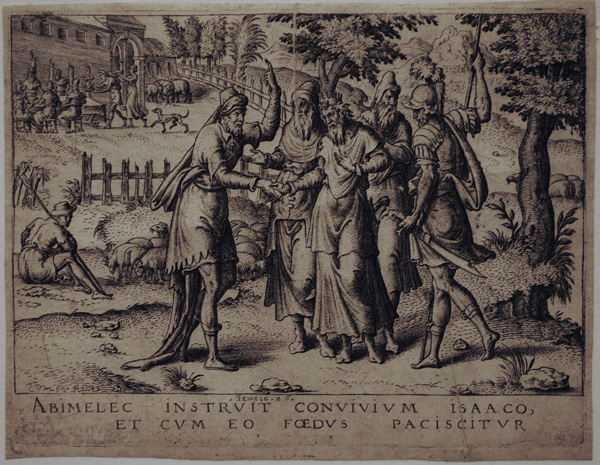 |
|
|
Abinelech and Isaac make ppeace (R-D56). Original engraving, c. 1555. Inscribed in the plate lower left: "Cvm Pri[ Regis." Genesis 26 is cited in the text below the engraving as the source of the scene: "Now there was a famine in the land, besides the former famine that had occurred in the days of Abraham. And Isaac went to Gerar, to King Abimelech of the Philistines. The Lord appeared to Isaac and said, ‘Do not go down to Egypt; settle in the land that I shall show you. Reside in this land as an alien, and I will be with you, and will bless you; for to you and to your descendants I will give all these lands, and I will fulfil the oath that I swore to your father Abraham. I will make your offspring as numerous as the stars of heaven, and will give to your offspring all these lands; and all the nations of the earth shall gain blessing for themselves through your offspring, because Abraham obeyed my voice and kept my charge, my commandments, my statutes, and my laws.’ So Isaac settled in Gerar. When the men of the place asked him about his wife, he said, ‘She is my sister’; for he was afraid to say, ‘My wife,’ thinking, ‘or else the men of the place might kill me for the sake of Rebekah, because she is attractive in appearance.’ When Isaac had been there a long time, King Abimelech of the Philistines looked out of a window and saw him fondling his wife Rebekah. So Abimelech called for Isaac, and said, ‘So she is your wife! Why then did you say, “She is my sister”?’ Isaac said to him, ‘Because I thought I might die because of her.’ Abimelech said, ‘What is this you have done to us? One of the people might easily have lain with your wife, and you would have brought guilt upon us.’ So Abimelech warned all the people, saying, ‘Whoever touches this man or his wife shall be put to death. " (Genesis 26: 1-11). A good, dark, crisp early imporession.There are two printer's creases top center and lower right where the paper seems to have beeen creased when it was printed but opened up after it ws dried. Image size: 78x114mm. Price: Please call or email for current pricing information.
|
|
|
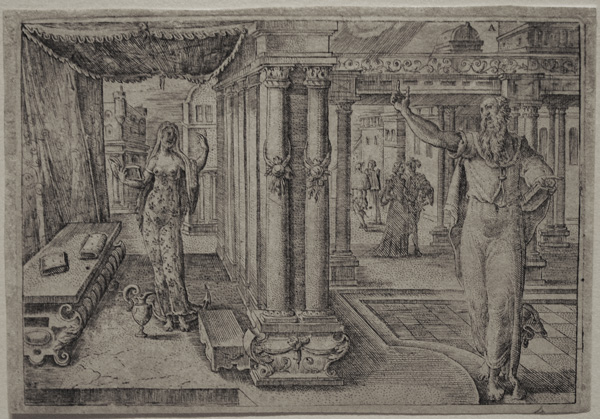 |
|
|
Original engraving (R-D 205). This is the first of a set of 20 engravings in a series of Emblèmes Moraux: Robert-Dumesnil ddescribes the subject as follows: A philosopher, leaving a sumptuous palace, proclaims upon the evils of the world while worldly couples are seen in the background and Hope, veiled, also seems to preach at left. A good but light impression with thread margins on all sides. Image size: 71x102mm. Price: Please call or email for current pricing information.
|
|
|
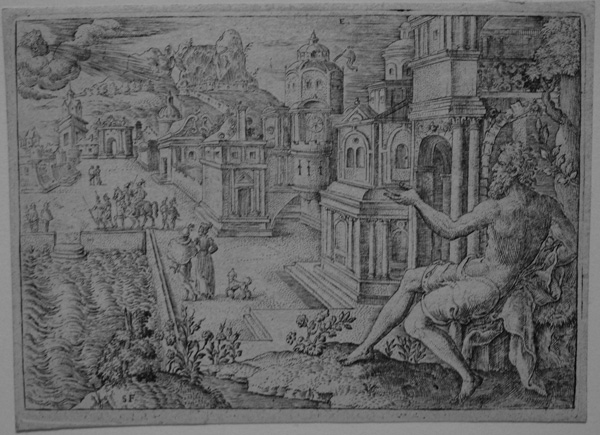 |
|
|
Original engraving (R-D 209). This is from a set of 20 engravings in a series of Emblèmes Moraux: Robert-Dumesnil describes the subject as follows: Seated at the right, very near a sumptuouos palace, seems to meditate on what he sees around it. Amidst the people, one finds in front of the palace one notices a king and his entourage.flowers bending to follow the sun, bots agitatred bythe waves and a gian wind them against a sea wall. THe moral sence of this piece is that the duration of worldly pleasures is like the life of a flower agitated by winds and waves. Signed in the plate lower left "SF" ["Stephanus fecit"]. A good but light impression with thread margins on the top and sides, but cut into the right side of the bottom. Image size: 73x99mm. Price: Please call or email for current pricing information.
|
|
|
 |
|
|
Original engraving (R-D 218). This is from a set of 20 engravings in a series of Emblèmes Moraux: Robert-Dumesnil describes the subject as follows: What the artist was trying to show by putting the globe at the center of the leadesrs of the Assyrians, the Persians, the Greeks, and the Romans. At the top left the plate is signed Stephanvs pater aet. 61 Foelicite scvlpsit Ihoani. filio inve. 1580" (i.e., Etienne, age 61, happily engraved this after a drawing by his son Jean. A very good impression with small margins, but with some black marks left top and bottom . Image size: 68x95mm. Price: Please call or email for current pricing information.
|
|
|
 |
|
|
|
Juno (R-D 360). One of a set of six oval compositions featuring pagan divinities from fables against a black background. Here we see Juno, Jove's wife and sister, with her peacock, a dragon on either side of her, holding a spear with a serpent curled around it. Signed in the plate bottom center: "Cum Privilegio Regis . Stephanvs Fecit." A very good impression with some time-soiling on the blank paper surrounding the image. Image size: 76x57mm. Price: Please call or email for current pricing information.
|
|
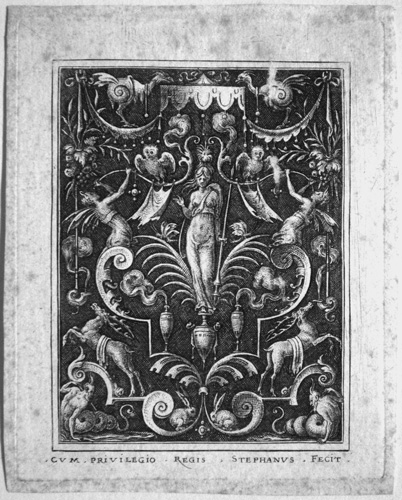 |
|
|
|
|
Bellona (R-D 417 (or 423). One of a set of six rectangular compositions featuring pagan divinities from fables against a black background. Here we see Bellona, the goddess of battles, standing on an urn. On either side of her, owls, the bird of woe, perch upon the elabote tracerie that surrounds her. Up at the top, we see a pair of large birds (ostriches?)—the one on the right with a small abraided area in the midst of its body; beneath her, a pair of stags with heavy antlers. At the very bottom in the cornsers a pair of sea serpents wait. above them, Signed in the plate bottom center: "Cum Privilegio Regis . Stephanvs Fecit." A very good impression with the backgound black.. Image size: 82x65mm. Price: Please call or email for current pricing information.
This is about life-size on our 27=inch monitor.
|
|
 |
|
|
Venus and Cupid (R-D 426 (or 423). One of a set of six rectangular compositions featuring pagan divinities from fables against a black background. Here we see Venus holding a large flaming torch with her son Cupid. Next to them on either side, a pair of flaming hearts surrounds them. At the edges, a pair of serpents, held on leashes by small, winged creatures with tails look up at Venus. At the very top on either side baskets hang down; beneath the but skightly closer to the center a pair of dovesare looking toward the edges of the composition. Signed in the plate bottom center: "Cum Privilegio Regis . Stephanvs Fecit." A good impression on a spightly grayer background with a a repaired tear at the left margin that just enters the composition. Image size: 82x65mm. Price: Please call or email for current pricing information.
This is about life-size on our 27=inch monitor.
|
|
|
 |
|
|
The Abduction of Helen (R-D 308 ii/ii). Engraving after Raphael based upon Marcantonio's engraving after Raphael (B. 209). A fine reverse copy by Delaune after Marcantonio. Thread margins. Paris, having accepted Venus's bribe to choose her as the most beautiful of the gods, gets Helen, wife of Menelaus, as his prize. He also begins a war that will end Paris' own death and the destruction of Troy. Provenance: Cantacuzene; with Jean de Gourmont's monogram added. Image size: 116x176mm. Price: SOLD.
|
|
|
Spaightwood Galleries, Inc.
To purchase, call us at 1-800-809-3343 (1-508-529-2511 in Upton MA & vicinity) or send an email to spaightwood@gmail.com.
We accept AmericanExpress, DiscoverCard, MasterCard, and Visa.
We also accept wire transfers and paypal.
For directions and visiting information, please call. We are, of course, always available over the web and by telephone (see above for contact information). Click the following for links to past shows and artists. For a visual tour of the gallery, please click here. For information about Andy Weiner and Sonja Hansard-Weiner, please click here. For a list of special offers currently available, see Specials.
All works are sold with an unconditional guarantee of authenticity (as described in our website listing).
Go back to the top of this page.
Visiting hours: Saturday 10:00 am to 5:00 pm and Sunday noon to 6:00 pm and other times by arrangement.
Please call to confirm your visit. Browsers and guests are welcome.
|
|
|
|
|
|
|
|
|
|
|
|
|
|
|
|
|
|
|
|
|
|
|
|
|
|
|
|
|
|
|
|
|
|
|
|













